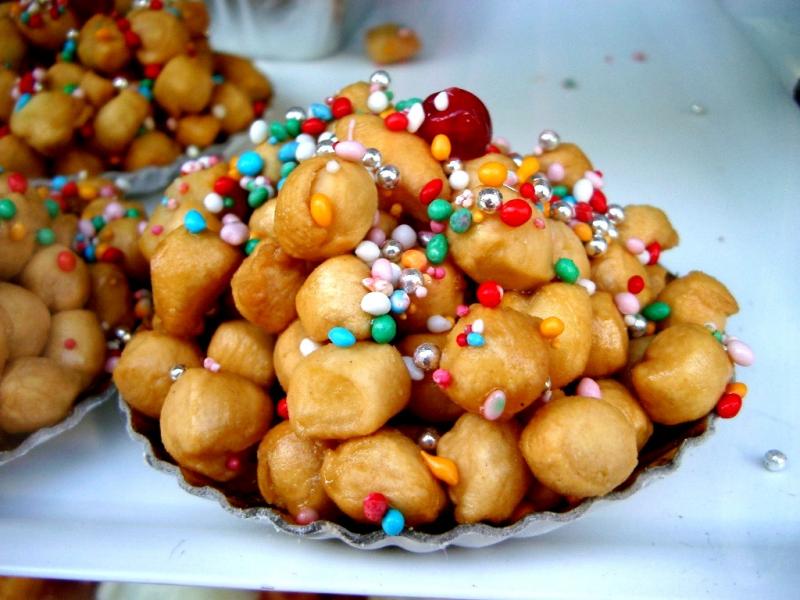The red spicy kick of a Calabrese soppressata, golden panzerotti oozing with Apulian mozzarella, rosemary scented lamb with crispy roast potatoes, rich, buttery panettone—Italian Christmas food is as varied as it gets. Every region, every province, every village has its own specialities for both Cena della Vigilia (Christmas Eve’s supper) and Pranzo di Natale (Christmas lunch).
Seafood—especially fried or boiled stockfish and capitone, a type of eel, stewed in tomato sauce—is common on Christmas Eve, but not everywhere. And the Christmas lunch fowl of many Northern and Central regions—capon in Piedmont and Lombardy, guinea fowl and duck in Tuscany—gives way to roast lamb (or, occasionally kid) in Lazio, the islands and some parts of the South.
Even panettone, which is originally from Milan but has now become Italy’s one national Christmas staple, is usually accompanied by local cakes, pastries and puddings—rich, raisin-studded gubana in Friuli Venezia Giulia, crunchy, rose-shaped carteddate in Apulia, honey-coated strufoli in Campania—as well as nuts, chocolates and torrone.
A lifetime would not be enough to try all the regional Christmas food worth savouring. If you are not a stickler for authenticity, however, you can concoct a marvellous Italian Christmas lunch by putting together some of the best recipes from each region. Here are a couple of ideas.
Starter: salumi calabresi
No Christmas lunch would be worthy of being called Italian without cold cuts and, at Christmas, the choice is particularly staggering. There is sweet and rosy culatello, made in Emilia Romagna with only the best ham cuts; Sardinian dry sausage, served with pecorino cheese and olives marinated in oil, vinegar, garlic and parsley; or sharp, juniper-scented mocetta from Val d’Aosta, served with honey and toasted bread. But if it’s spicy oomph you are after, little beats cold cuts from Calabria: flattish, grainy soppressata—either sweet (but don’t be fooled, it has black pepper) or fiery (made blazing red by chilli), capocollo calabrese, a coppa with chilli attitude, and, for the really brave, the spreadable ‘nduja di Spilinga, made with the fattest, most flavoursome pork cuts and seasoned with so much chilli that it gives it a vivid crimson colour (the traditional recipe calls for at least 300g of chilli for every kilo of meat, and up to 500g). Serve with pecorino di Crotone for a richer starter.
First course: tortellini in brodo
No contest here: Italy’s best Christmas first course has to be tortellini in brodo. Sure, you could be tempted by opulent layers of lasagne dripping mince and mozzarella, or minuscule but rich Piedmontese agnolotti filled with roast meat and served with God’s gravy. But tiny tortellini di carne swimming in a golden broth have that homely, comforting quality that no other food can rival. The intensely aromatic broth—made with capon, beef and parmesan, as well as the classic Italian triad of celery, carrot and onion—primes the palate, before the thin rings of dough split to release their rich filling of meat, parma ham, mortadella and parmesan. Whoever said broth is only for the sick has never tried this one. For a simple recipe (which uses chicken, not capon) see: http://www.cucinait.com/default.aspx?idpage=889&idricetta=15792&idLang=2...

Main course: Cappone ripieno al forno
t is a tough call between roast capon and roast lamb a a main course. Both are extremely aromatic and full of flavour, but the ripieno (stuffing) tilts the balance towards the capon, making it positively decadent and perfect for a Christmas lunch. The capon’s crunchy skin and soft, tender meat tease the mouth first, but then the rich stuffing—parmesan, eggs, mince, herbs and, depending on the region, mortadella or sausage—hits the tastebuds with a punch. Each mouthful becomes a waltz of delicate and flavoursome, crispy and soft. To make the most of this dish try and get a capon from Morozzo, a small village near Cuneo. There, capons roam free during the day, and are only fed a vegetarian diet. This makes production expensive—so much so that the cappone di Morozzo was at risk of disappearing until ten years ago, when it became one of the first Slow Food presidia—but it also yields what is undoubtedly the best capon in Italy. A good recipe is available (in Italian only) here: http://www.frasi.net/ricette/ricetta20611.htm

Side: Insalata di rinforzo
This salad, which hails from Naples, is usually a starter served on Christmas Eve, but, as a side, it adds a fresh touch to the Christmas lunch table. Olives, capers, peppers and anchovies add bite to al dente cauliflower but the salad, simply sprinkled with olive oil, salt and vinegar, remains a counterpoint to the richness of the rest of the meal. And insalata di rinforzo has another advantage: it fuels conversation. You can spend hours speculating about its unusual name. Some believe it was called di rinforzo because its freshness reinforces the appetite. But another theory wants the name to derive from the fact that new ingredients were added to it every day during the holidays, thus reinforcing the dish. For a more authentic side dish, choose stir-fried broccoli. Nigella Lawson’s sophisticated version of the Insalata di Rinforzo is available here: http://www.foodnetwork.com/recipes/nigella-lawson/insalata-di-rinforzo-r...
Dessert: Struffoli
If there is a dish that encapsulates the spirit of Naples—grand but simple, decadent and joyous—it is struffoli, the traditional dessert served there both on Christmas Eve and on Christmas Day. It is hard to believe that so much flavour can be packed in what are essentially miniature dough balls. But tiny struffoli are drenched in a sea of honey and sprinkled with diavulilli (non-pareils), candied peel, and, if you can find it, cucuzzata (candied pumpkin). Crunchy, sticky, colourful, they are as fun to eat as they are delicious.
A fairly authentic recipe is available here: http://www.bigoven.com/35624-Struffoli-Italian-Honey-Cookies-recipe.html









